



 Walt Kelly's
most famous creation is "Pogo" and his most famous
phrase is "We have met the enemy and he is us," a rallying
cry for a generation of conservationists.
Walt Kelly's
most famous creation is "Pogo" and his most famous
phrase is "We have met the enemy and he is us," a rallying
cry for a generation of conservationists.
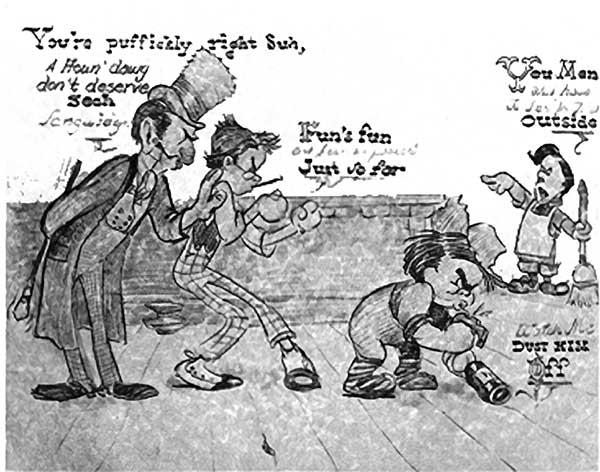
He was born in 1913 and his father believed that humans were
"bad at talking, bad at remembering language, and bad at
spelling; but we are just great at remembering pictures."
One can imagine this having a lasting impression on young Walt.
From 1935 to 1941, he worked for another famous Walt - Walt Disney.
He was a story man and animator with credits on Pinocchio,
Dumbo and Fantasia. He was also quick with a pencil
and an accomplished letterer, as shown in a bullpen gag above
right.
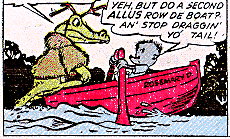
 During 1935
and 1936, his work also appeared in the fledgling comic book medium
working for the company that was to become DC Comics. However,
it was in Dell's Animal Comics that Pogo was born in 1941.
He was just a featured player in the "Albert the Alligator"
strip, but assumed a larger, then starring role within a few years.
The panel above left, from issue #9 (June-July 1944), shows the
early use of a Kelly trademark, the boat with a name on the side.
He would use this technique to salute friends throughout his career.
The panel above right, also from the same issue, shows the early
usage of human characters, a notion that was abandoned by the
time the strip moved from the comic books to the comic pages of
the newspapers.
During 1935
and 1936, his work also appeared in the fledgling comic book medium
working for the company that was to become DC Comics. However,
it was in Dell's Animal Comics that Pogo was born in 1941.
He was just a featured player in the "Albert the Alligator"
strip, but assumed a larger, then starring role within a few years.
The panel above left, from issue #9 (June-July 1944), shows the
early use of a Kelly trademark, the boat with a name on the side.
He would use this technique to salute friends throughout his career.
The panel above right, also from the same issue, shows the early
usage of human characters, a notion that was abandoned by the
time the strip moved from the comic books to the comic pages of
the newspapers.
 Kelly's
work during the 1940's appeared only in comics published by Dell.
Along with Animal Comics, he can be found in Fairy Tale
Parade and the wonderful Mother Goose Christmas and
Easter specials. The most amazing images I've found in his early
work show a totally unexpected influence: Franklin Booth! As difficult as that is to
believe, there is no denying the antecedents of the image at left.
This was inside front cover for Fairy Tale Parade #5 (Feb-Mar
1943) and there was a similar image inside the rear cover. Other,
more recognizable influences were Percy Crosby,
animated cartoons, and the often overlooked Dan Noonan. The issues
of these comics from the early 1940's are treasure troves of cartooning
at its finest.
Kelly's
work during the 1940's appeared only in comics published by Dell.
Along with Animal Comics, he can be found in Fairy Tale
Parade and the wonderful Mother Goose Christmas and
Easter specials. The most amazing images I've found in his early
work show a totally unexpected influence: Franklin Booth! As difficult as that is to
believe, there is no denying the antecedents of the image at left.
This was inside front cover for Fairy Tale Parade #5 (Feb-Mar
1943) and there was a similar image inside the rear cover. Other,
more recognizable influences were Percy Crosby,
animated cartoons, and the often overlooked Dan Noonan. The issues
of these comics from the early 1940's are treasure troves of cartooning
at its finest.
In 1947, he brought his talent to the book world with the Complete Nursery Song Book and in 1948 "Pogo" began to appear in the New York Star, for whom Kelly served as Art Director and Political Cartoonist. The Star existed only from June 23, 1948 to Jan. 28, 1949 and had a peak circulation of 150,000 in New York and Philadelphia. The "Pogo" strip began Oct. 4. The very first strip is shown below (from The Okefenokee Star #1, Spring 1977) and even features a prototype Churchy La Femme.

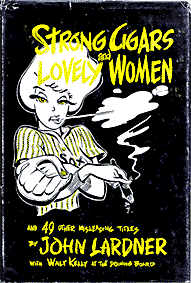
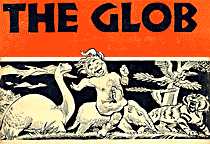 By 1952, Kelly
and Pogo were well established. In 1951, he'd illustrated Strong
Cigars and Lovely Women, a collection of humorous essays by
John Lardner. The first in a long series of reprint books was
also released in 1951. It was titled, Pogo and it was followed
by I Go Pogo in 1952, The Pogo Papers in 1953, etc,
beginning a string of reprints that would continue into the 1970's.
1952 also saw the release of John O'Reilly's The Glob with
drawings by Walt. The book was so popular that it was reprinted
before it was published. Kelly got to draw cavemen and
dinosaurs and saber-tooth tigers and all kinds of wild folks and
flora. In 1953, he started a parallel series of annuals featuring reprints of the Sunday strip and new material. With titles like
By 1952, Kelly
and Pogo were well established. In 1951, he'd illustrated Strong
Cigars and Lovely Women, a collection of humorous essays by
John Lardner. The first in a long series of reprint books was
also released in 1951. It was titled, Pogo and it was followed
by I Go Pogo in 1952, The Pogo Papers in 1953, etc,
beginning a string of reprints that would continue into the 1970's.
1952 also saw the release of John O'Reilly's The Glob with
drawings by Walt. The book was so popular that it was reprinted
before it was published. Kelly got to draw cavemen and
dinosaurs and saber-tooth tigers and all kinds of wild folks and
flora. In 1953, he started a parallel series of annuals featuring reprints of the Sunday strip and new material. With titles like Uncle Pogo's So-So Stories and Pogo Stepmother Goose, these hearkened back to the Mother Goose Christmas
and Easter specials from Dell Comics. I'm sure that the
Rocky and Bullwinkle Show writers were exposed to these
as they display a similar nonsensical appeal with their Fractured
Fairy Tales.
Uncle Pogo's So-So Stories and Pogo Stepmother Goose, these hearkened back to the Mother Goose Christmas
and Easter specials from Dell Comics. I'm sure that the
Rocky and Bullwinkle Show writers were exposed to these
as they display a similar nonsensical appeal with their Fractured
Fairy Tales.
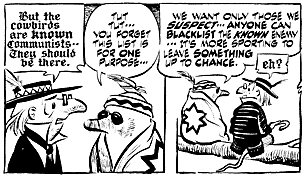 But
Kelly was much more than nonsense and cute li'l animals. What
made him extra special was his fearless attacks on political figures
that abused their powers. In titles like The Jack Acid Society
Black Book, he skewers the McCarthy-ites and their witch hunts.
(Note in the two panels at left that the Deacon's speech lettering
echoes the early Disney cartoon above.) This was followed in 1966
by my favorite, The Pogo Poop Book, loaded with original
material and even featuring a beautiful story, Mouse Into Elephant,
done in pencil (featuring a mouse named Gnot-Even - if
you had ever wondered where that came from).
But
Kelly was much more than nonsense and cute li'l animals. What
made him extra special was his fearless attacks on political figures
that abused their powers. In titles like The Jack Acid Society
Black Book, he skewers the McCarthy-ites and their witch hunts.
(Note in the two panels at left that the Deacon's speech lettering
echoes the early Disney cartoon above.) This was followed in 1966
by my favorite, The Pogo Poop Book, loaded with original
material and even featuring a beautiful story, Mouse Into Elephant,
done in pencil (featuring a mouse named Gnot-Even - if
you had ever wondered where that came from).

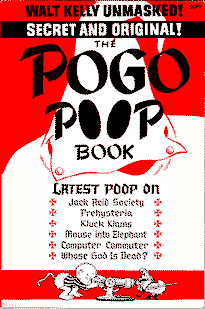 The third
book in this vein, though by no means solely devoted to it, is
the aforementioned We Have Met the Enemy and He is Us,
with cover caricatures of the infamous trio of Hoover, Mitchell
and Agnew, as shown at left. The Sixties and early Seventies (Kelly
died in 1973) was a period of political struggle and polarization
in this country. Kelly wore his politics on his strip and was
often criticized and censored by more conservative newspapers.
He didn't care. He was prepared to lose newspapers rather than
his principles. Sometimes the "Pogo" strip would
be more biting than the editorial cartoons, but somehow Kelly
always managed to insert a joke or an insightful turn of a phrase
at the end of each strip. His pen and wit were sharp and I think
history has proven them to be dead on target. He is missed.
The third
book in this vein, though by no means solely devoted to it, is
the aforementioned We Have Met the Enemy and He is Us,
with cover caricatures of the infamous trio of Hoover, Mitchell
and Agnew, as shown at left. The Sixties and early Seventies (Kelly
died in 1973) was a period of political struggle and polarization
in this country. Kelly wore his politics on his strip and was
often criticized and censored by more conservative newspapers.
He didn't care. He was prepared to lose newspapers rather than
his principles. Sometimes the "Pogo" strip would
be more biting than the editorial cartoons, but somehow Kelly
always managed to insert a joke or an insightful turn of a phrase
at the end of each strip. His pen and wit were sharp and I think
history has proven them to be dead on target. He is missed.

To find out more about Walt Kelly, see:
| Five Boyhoods | Martin Levin, ed., 1962 Doubleday & Co. |
| The Who's Who of American Comic Books | Jerry Bails & Hames Ware, 1973 and 1997 |
| The Okefenokee Star | Swamp Yankee Studios, 1977-1982 |
| The Vadeboncoeur Collection of Knowldege | Jim Vadeboncoeur, Jr. 1998 |
|
Illustrations copyright by their respective
owners. This page written, designed & © 1998 by Jim Vadeboncoeur, Jr. Updated 2011. |
